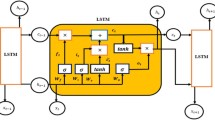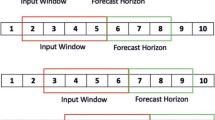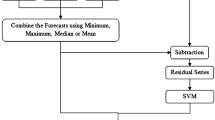Abstract
The prediction of a time series such as climate indices and the sunspot number (SSN) with long-term oscillatory behaviors has been a challenging task due to the complex combination of oscillations. Frequency extraction algorithms have been developed to separate a time series into different oscillation components according to frequency, such as empirical model decomposition (EMD) and wavelet analysis. In the current study, the deep learning long short-term memory (LSTM) model was employed to predict the oscillation components extracted using EMD. The SSN series was modeled with the hybrid EMD-LSTM model. The simulation study results indicate that the LSTM model reproduces the smooth cyclic pattern of the sine function, and only a few hidden units are needed to model it. The EMD-LSTM model achieves better performance than does the LSTM model for mid-range SSN predictions while the LSTM achieves better performance within the first few time lags. However, the cyclic prediction of the SSN requires mid-range lags; thus, the superior performance of the EMD-LSTM model for these lags cannot be ignored. Furthermore, the remaining components from the significant EMD signals can be modeled to reveal the variability (or uncertainty) in the prediction. The summed residual is fitted by k-nearest neighbor resampling. The final SSN prediction results show that the EMD-LSTM model predicts a later and larger SSN for Solar Cycle 25 than does the LSTM model. Overall, the results lead to the conclusion that the EMD-LSTM model might be a suitable alternative for modeling complex sunspot time series with cyclic patterns.















Similar content being viewed by others
References
Barzegar, R., Aalami, M.T., Adamowski, J.: 2020, Short-term water quality variable prediction using a hybrid CNN–LSTM deep learning model. Stoch. Environ. Res. Risk Assess. DOI.
Cao, J., Li, Z., Li, J.: 2019, Financial time series forecasting model based on CEEMDAN and LSTM. Physica A519, 1. DOI.
Chen, L., Chi, Y., Guan, Y., Fan, J.: 2019, A hybrid attention-based EMD-LSTM model for financial time series prediction. In: 2019 2nd International Conference on Artificial Intelligence and Big Data, ICAIBD 2019, 113.
Durocher, M., Lee, T.S., Ouarda, T.B.M.J., Chebana, F.: 2015, Hybrid signal detection approach for hydro-meteorological variables combining EMD and cross-wavelet analysis. Int. J. Climatol. DOI.
Foufoula-Georgiou, E., Kumar, P. (eds.): 1994, Wavelets in Geophysics, Academic Press, San Diego, 373.
Gonçalves, Í.G., Echer, E., Frigo, E.: 2020, Sunspot cycle prediction using warped Gaussian process regression. Adv. Space Res.65(1), 1. DOI.
Goodfellow, I., Bengion, Y., Courville, A.: 2016, Deep Learning775, MIT Press, Cambridge, 9780262035613.
Greff, K., Srivastava, R.K., Koutnik, J., Steunebrink, B.R., Schmidhuber, J.: 2017, LSTM: a search space Odyssey. IEEE Trans. Neural Netw. Learn. Syst.28(10), 17189090.
Hochreiter, S., Schmidhuber, J.: 1997, Long short-term memory. Neural Comput.9(8), 1735.
Huang, N.E., et al.: 1998, The empirical mode decomposition and the Hilbert spectrum for nonlinear and non-stationary time series analysis. Proc. Roy. Soc., Math. Phys. Eng. Sci.454(1971), 903.
Huang, N.E., Wu, M.L., Qu, W.D., Long, S.R., Shen, S.S.P.: 2003, Applications of Hilbert-Huang transform to non-stationary financial time series analysis. Appl. Stoch. Models Bus. Ind.19(3), 245. DOI.
Kane, R.P.: 2007, A preliminary estimate of the size of the coming solar cycle 24, based on Ohl’s precursor method. Solar Phys.243(2), 205. DOI.
Kwon, H.H., Lall, U., Khalil, A.F.: 2007, Stochastic simulation model for nonstationary time series using an autoregressive wavelet decomposition: applications to rainfall and temperature. Water Resour. Res.43(5), W05407. DOI.
Lee, T., Ouarda, T.B.M.J.: 2010, Long-term prediction of precipitation and hydrologic extremes with nonstationary oscillation processes. J. Geophys. Res., Atmos.115(13), D13107. DOI.
Lee, T., Ouarda, T.B.M.J.: 2011, Prediction of climate nonstationary oscillation processes with empirical mode decomposition. J. Geophys. Res., Atmos.116(6), D06107. DOI.
Lee, T., Ouarda, T.B.M.J.: 2012a, Stochastic simulation of nonstationary oscillation hydroclimatic processes using empirical mode decomposition. Water Resour. Res.48(2), W02514. DOI.
Lee, T., Ouarda, T.B.M.J.: 2012b, An EMD and PCA hybrid approach for separating noise from signal, and signal in climate change detection. Int. J. Climatol.32(4), 624. DOI.
Lee, T., Ouarda, T.B.M.J.: 2019, Multivariate nonstationary oscillation simulation of climate indices with empirical mode decomposition. Water Resour. Res.55(6), 5033. DOI.
Lee, T., Ouarda, T.B.M.J., Li, J.: 2013, An orchestrated climate song from the Pacific and Atlantic oceans and its implication on climatological processes. Int. J. Climatol.33(4), 793. DOI.
Lee, T., Ouarda, T.B.M.J., Yoon, S.: 2017, KNN-based local linear regression for the analysis and simulation of low flow extremes under climatic influence. Clim. Dyn.49, 9. DOI.
Lee, T., Singh, V.P.: 2018, Statistical Downscaling for Hydrological and Environmental Applications165, CRC Press, Boca Raton, 165. ISBN 9781138625969
Lee, T., Shin, J.Y., Kim, J.S., Singh, V.P.: 2020, Stochastic simulation on reproducing long-term memory of hydroclimatological variables using deep learning model. J. Hydrol.582, 124540. DOI.
Messerotti, M., et al.: 2009, Solar weather event modelling and prediction. Space Sci. Rev.147(3–4), 121. DOI.
Okoh, D.I., Seemala, G.K., Rabiu, A.B., Uwamahoro, J., Habarulema, J.B., Aggarwal, M.: 2018, A hybrid regression-neural network (HR-NN) method for forecasting the solar activity. Space Weather16(9), 1424. DOI.
Pala, Z., Atici, R.: 2019, Forecasting sunspot time series using deep learning methods. Solar Phys.294(5), 50. DOI.
Pesnell, W.D.: 2012, Solar cycle predictions. Solar Phys.281(1), 507. DOI (Invited Review)
Rigozo, N.R., Souza Echer, M.P., Evangelista, H., Nordemann, D.J.R., Echer, E.: 2011, Prediction of sunspot number amplitude and solar cycle length for cycles 24 and 25. J. Atmos. Solar-Terr. Phys.73(11–12), 1294. DOI.
Stollenga, M.F., Byeon, W., Liwicki, M., Schmidhuber, J.: 2015 January, Parallel multi-dimensional LSTM, with application to fast biomedical volumetric image segmentation, C3. Adv. Neural Inf. Process. Syst. arXiv.
Wang, H., Zhao, X., Zhang, X., Wu, D., Du, X.: 2019, Long time series land cover classification in China from 1982 to 2015 based on Bi-LSTM deep learning. Remote Sens.11(14), 1639. DOI.
Wu, Z., Huang, N.E.: 2004, A study of the characteristics of white noise using the empirical mode decomposition method. Proc. Roy. Soc., Math. Phys. Eng. Sci.460(2046), 1597.
Wu, Z.H., Huang, N.E.: 2005, In: Huang, N.E., Shen, S.P. (eds.) Hilbert-Huang Transform and Its Applications, World Scientific, Hackensack, 125.
Wu, Z.H., Huang, N.E.: 2009, Ensemble empirical mode decomposition: a noise-assisted data analysis method. Adv. Adapt. Data Anal.1(1), 1.
Xu, T., Wu, J., Wu, Z.S., Li, Q.: 2008, Long-term sunspot number prediction based on EMD analysis and AR model. Chin. J. Astron. Astrophys.8(3). DOI.
Yuan, X., Chen, C., Lei, X., Yuan, Y., Muhammad Adnan, R.: 2018, Monthly runoff forecasting based on LSTM–ALO model. Stoch. Environ. Res. Risk Assess.32(8), 2199. DOI.
Zhang, B.: 2018, Foreign exchange rates forecasting with an EMD-LSTM neural networks model. J. Phys. Conf. Ser.1053(1), 012005.
Acknowledgement
This work was supported by the National Research Foundation of Korea (NRF) through a grant funded by the Korean Government (MEST) (2018R1A2B6001799).
Author information
Authors and Affiliations
Corresponding author
Ethics declarations
Declaration of Potential Conflicts of Interest
The author has no conflicts of interest to declare.
Additional information
Publisher’s Note
Springer Nature remains neutral with regard to jurisdictional claims in published maps and institutional affiliations.
Rights and permissions
About this article
Cite this article
Lee, T. EMD and LSTM Hybrid Deep Learning Model for Predicting Sunspot Number Time Series with a Cyclic Pattern. Sol Phys 295, 82 (2020). https://doi.org/10.1007/s11207-020-01653-9
Received:
Accepted:
Published:
DOI: https://doi.org/10.1007/s11207-020-01653-9




